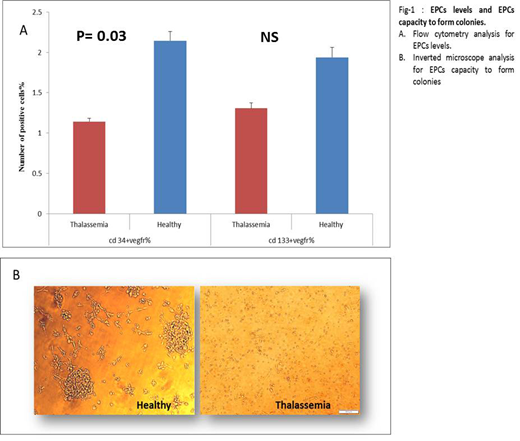There is a high incidence of venous thromboembolic complications in patients with beta thalassemia .Recently, a high incidence of asymptomatic multiple silent cerebral infarcts, presumably of arterial origin, were demonstrated in patients with beta thalassemia major (TM) and intermedia. The etiology remains unclear. Endothelial progenitor cells (EPCs) derive from the bone marrow and contribute to regeneration of endothelial damage. We hypothesized that the change in EPCs contributes to the vascular events in patients with TM and that patients have high markers for arterial thromboembolism.
Study aim: To assess the change in the number and function of EPCs in TM patients.
Methods: Blood samples were drawn from adult patients with TM before blood transfusion and from healthy volunteers. EPCs were isolated from peripheral mononuclear cells by using a Ficoll density-gradient centrifugation. EPCs' levels were detected by flow cytometry, namely by co-expression of VEGFR-2 in CD34 or CD133 positive cells. EPCs were cultured for 7 days after which functional properties were evaluated by: their capacity to form colonies using light microscopy (a colony forming unit (CFU) defined as a cluster of at least 100 flat cells surrounding a cluster of rounded cells) as well as by using a viability assay (using the 3-[4,5-dimethylthiazol-2-yl]-2,5-diphenyl tetrazolium bromide (MTT) assay). The adhesion molecule P- selectin and the chemokine SDF1 were measured by using Elisa kits according to the manufacturer instructions.
Results: Thirty five patients (median age 35 range 27-47y) and 15 healthy volunteers (median age 34.5 range 30-50y) were included. Lower levels of CD34/VEGFR-2 cells and a trend towards CD133/ VEGFR-2 cells were observed in TM patients (Figure 1A). Viability of EPCs and their ability to perform colonies were markedly reduced in TM patients compared to controls; mean MTT 0.05± 0.05 in TM vs. 0.23±0.08 (p<0.01), median number of CFU = 0, range 0-3 in TM vs. 4, range 1-6 in controls (p<0.001), (a representative picture, Figure 1b). SDF1a and P selectin levels were significantly higher in TM compared to healthy volunteers (p=0.05 and P<0.01 respectively).
Conclusions: Our results suggest that patients with TM have reduced number and function of EPCs. This may contribute to the silent cerebral infarcts and hypercoagulable state in thalassemia. Furthermore, SDF1a and P selectin, both markers for coronary artery disease were higher in TM. Further studies are planned to establish the possible role of other cytokines in this process.
Spectre:Pfizer: Honoraria; Sanofi: Honoraria, Membership on an entity's Board of Directors or advisory committees; Novartis: Honoraria, Membership on an entity's Board of Directors or advisory committees; Boeringer ingelheim: Honoraria; Bayer: Membership on an entity's Board of Directors or advisory committees.
Author notes
Asterisk with author names denotes non-ASH members.


This feature is available to Subscribers Only
Sign In or Create an Account Close Modal